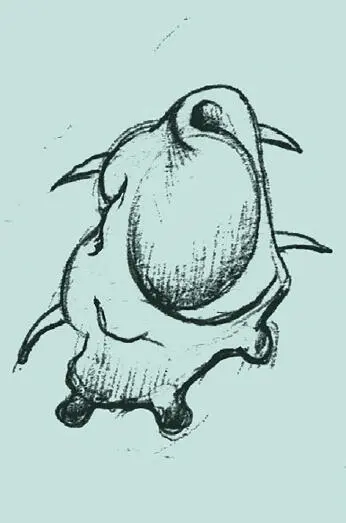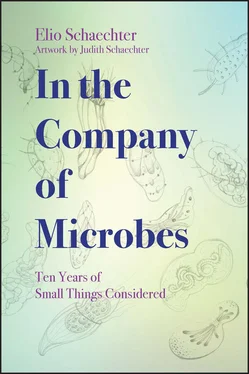1 ...6 7 8 10 11 12 ...17 Let us thumb through the catalogue of viral genomes: here we find the familiar double-stranded DNA, including both linear and circular genomes, but also some with not-so-familiar twists—poxviruses, for example, covalently closing both ends of their linear double-stranded DNA genomes. We also find an abundance of themes not found anywhere among the domains of cellular life: thus, there are viruses with single-stranded DNA genomes and viruses with single-stranded RNA genomes, the latter including some that are negative-sense, some positive-sense, and some part positive and part negative (ambisense). Additionally, there are viruses with double-stranded RNA genomes, and if that isn’t bizarre enough, there are viruses with segmented RNA genomes (to which the influenza virus belongs), whose virions incorporate a precise complement of eight different RNA segments.
Equally impressive are the reoviruses, with genomes composed of a dozen different segments of double-stranded RNA. Replicate that! And there are retroviruses, whose genomes are sometimes RNA (in the virion), and at other times double-stranded DNA (upon entering a host cell). Hepadnaviruses, possible cousins to the retroviruses, have gapped double-stranded DNA genomes with a bit of RNA thrown in, which they, too, convert to DNA by means of reverse transcriptase.
This diversity of genome styles each comes with its own uniquely-tailored replication system dictated in part by the need (shared by all viruses) to generate mRNA (because all viruses rely on host cells for translation). Importantly, there is very little if any phylogenetic evidence for a common ancestry connecting all the different viral types, or for grouping viruses together. Attempts to prove the existence of a last universal common ancestor of all viruses may be folly, as it is entirely possible that no such ancestor ever existed (that is, what we lump together as “viruses” actually represent uniquely evolved biological entities that happen, just by chance, to have taken on obligate intracellular parasitism as a mode of existence). At best, and by stretching the limits of phylogenetic comparisons, some of the RNA viruses can be combined into hypothetical “supergroups.”
The tables thus turned, the viruses demand a fair redistricting, with the viral realm to include no fewer than seven domains to our three. They also ask that we wear name tags, since they are having trouble remembering how to tell an elephant from a bacillus.

Welkin Johnson is Professor and Chair of Biology at Boston College.
November 19, 2012
bit.ly/1GfyjMb
#17

by Elio
What if someone discovered a fourth (or fifth, sixth, etc.) domain of life?
May 28, 2007
bit.ly/1GQ7OHL
9
Feynman Said “Just Look at the Thing!”
by Jan Spitzer

On October 28, 2010, Elio posted this Talmudic Question: “ Richard Feynman, the famous physicist, said : It is very easy to answer many of these fundamental biological questions; you just look at the thing! To take him up on it, imagine a microscope that lets you observe single molecules in a living cell at one Angström resolution. What’s the first thing you would do with it ?” Thank you, Elio, for allowing me to provide some thoughts on the matter from the perspective of a physical chemist/chemical engineer.
Such a microscope could indeed help address some of the fundamental issues in biology today. I must say up front that I am surprised that microbiologists would want to look at (small) molecules (“pure” chemistry), or at the chemical details of “bigger things,” as suggested by the very notion of using a “Schaechter-Feynman supermicroscope.” This hypothetical instrument would have a resolution of 0.1nm with exposure times in the picosecond range (making it a bit akin to an infrared spectrophotometer) and would operate in Feynman’s quantum mechanical world. It would look at the chemistry of biology, dissecting cells into their molecular components that are then chemically characterized individually. But let me explain this more…
What Should We Look At?
Feynman suggested that “seeing better” is “better.” However, what we see often depends on what we are looking for. At such very high resolutions, we risk focusing on details so small that we lose context and perspective, like looking at the leaves of individual trees and losing sight of the surrounding forest. We will also miss the lakes, the meadows, and even the blazing sunset—the reddish light scattering forward from the nucleating particles of the nano-fog, the beauty of which, Feynman insists, a mere poet may miss (1). Similarly, a narrowly focused molecular researcher overlooks the relationship of the detail to the living whole (2,3). I would suggest observing at a slightly larger scale, say dimensions of 10 to 100 nm and durations of a millisecond, to see the “metabolons,” “modules,” “hyperstructures,” and the many functional protein complexes (signalsomes, stressosomes, transcriptomes, dividisomes, etc.) to find out if and how they exist as discrete physical objects. We might then see these large, transient biomacromolecular clusters appear and disappear, and see them interact at the subcellular level. We could take full advantage of the atomic resolution of this supermicroscope to visualize ionic currents of ATP, GTP, phosphates, K and Mg ions, bicarbonate, glutamate, etc., tracking them from their origins to where they sink and disappear. Even the vectorial ionic currents generated in the cell envelope with their movements through and around the large “omic” biomacromolecular clusters could be visualized as the cell grows. What would we see when a bacterial cell begins to die? Will the ionic currents “die”? (4-6). So many events to explore with our supermicroscope!
What Did Feynman Actually Say?
Feynman’s suggestion betrays the physicist’s weltanschauung, the world view that Feynman-influenced biologists focused on. At the time, however, neither biologists nor physicists understood what the “thing” to look at was. The situation then was similar to one that chemists had to face 100 years earlier (circa 1860)—having to develop methods of chemical analysis: first, qualitative—to know what kind of atoms and molecules one is dealing with, and then quantitative—how many, in what proportions, their structures, the chemical reactions between them, etc. It is worthwhile to reprint that section of Feynman’s (“nanotechnology”) talk:
“ What are the most central and fundamental problems of biology today? They are questions like: What is the sequence of bases in the DNA? What happens when you have a mutation? How is the base order in the DNA connected to the order of amino acids in the protein? What is the structure of the RNA; is it single-chain or double-chain, and how is it related in its order of bases to the DNA? What is the organization of the microsomes? How are proteins synthesized? Where does the RNA go? How does it sit? Where do the proteins sit? Where do the amino acids go in? In photosynthesis, where is the chlorophyll; how is it arranged; where are the carotenoids involved in this thing? What is the system of the conversion of light into chemical energy? It is very easy to answer many of these fundamental biological questions; you just look at the thing! You will see the order of bases in the chain; you will see the structure of the microsome .”
Читать дальше















